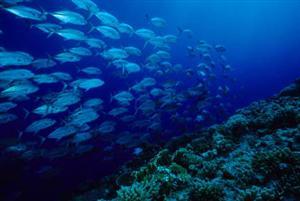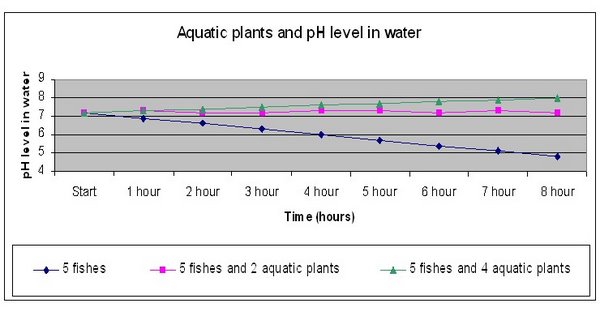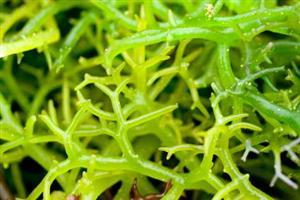| Complexity level: | 5 |
| Project cost ($): | 35 |
| Time required: | 1 hour to prepare, 8 hours for experiment |
| Material availability: | Easily found |
| Safety concerns: | None |
Hypothesis
Increasing the amount of aquatic plants in the aquarium will reduce the acidity and increase the pH level of the water.
Overview
Aquatic plants and animals
Aquatic plants photosynthesize under water. They absorb the carbon dioxide in the water and release oxygen. This helps to increase the oxygen content in the water, which is then used by aquatic animals for respiration. Through respiration, both plants and animals take in oxygen and release carbon dioxide.
This underwater process of the exchange of gases is very similar to the photosynthesis by plants on dry land, and the respiration by both land plants and animals.
The ideal pH level for fishes is between 6.6 to 7.4 whereas the ideal pH level for aquatic plants is between 6 to 9.
Ocean acidification
Industrialization and human activities such as deforestation and burning of fossil fuel has led to increased levels of carbon dioxide in the air. Part of this carbon dioxide is absorbed by the ocean, thus reducing its pH levels and making it more acidic. A pH drop from 8.18 to 8.10 has been recorded over a period of 250 years.
If this trend should continue, marine life may be adversely affected and this will create a domino effect which will ripple up through the food chain and eventually affect man to a great extent.
Scientific Terms
Materials
- The materials required for this experiment:
- 15 guppy fishes
- 3 fish tanks which can hold 1 liter of water each
- 3 liters of water
- 6 aquatic seaweed plants
- 1 fish net to transfer the fish
- pH paper
- 1 clock to record time
Procedure
- For this experiment, the independent variable is the concentration of the carbon dioxide, which is consumed by the aquatic plants. The dependent variable is the level of acidity in the water. This is measured using a pH paper. The constants (control variables) are the type of water used (i.e. tap water, sea water etc), the amount of water and the number of fishes.
- Expose all 3 fish tanks to bright sunlight as the plants require this to photosynthesize
- The 3 fish tanks are filled with 1 liter of water each. The starting pH level of the water in the tank is measured using the pH paper.
- 5 guppies are placed in each tank with the help of the fish net. The fishes respirate, absorbing oxygen and releasing carbon dioxide into the water. The fishes are used to help simulate the increase of acidity in the water due to increased carbon dioxide content.
- The first tank will only have the 5 fishes and no aquatic plants. Two aquatic seaweed plants are placed in the second tank and the remaining 4 aquatic seaweed plants are placed in the third tank.
- The pH levels of the water in the 3 tanks are taken every hour using the pH paper and the measurements are recorded in the table given below.

Results
The results show that the acidity in the water will increase if there are only fishes and no aquatic plant. Increasing the number of aquatic plants help to reduce the acidity of the water.
| Water tank | pH level of the water in the tank | ||||||||
| Start | 1 hour | 2 hour | 3 hour | 4 hour | 5 hour | 6 hour | 7 hour | 8 hour | |
| 5 fishes and no aquatic plants | 7.2 | 6.9 | 6.6 | 6.3 | 6.0 | 5.7 | 5.4 | 5.1 | 4.8 |
| 5 fishes and 2 aquatic plants | 7.2 | 7.3 | 7.2 | 7.2 | 7.3 | 7.3 | 7.2 | 7.3 | 7.2 |
| 5 fishes and 4 aquatic plants | 7.2 | 7.3 | 7.4 | 7.5 | 7.6 | 7.7 | 7.8 | 7.9 | 8.0 |
Use the below graph to plot the results of above observation.

Conclusion
The hypothesis that increasing the amount of aquatic plants in the aquarium will reduce the acidity and increase the pH level of the water is proven to be true. The aquatic plants use carbon dioxide in the water for photosynthesis and therefore reduce the acidity of the water.
The increase in carbon dioxide lowers the pH level and thus, increases the acidity of the water. However, the process of photosynthesis by aquatic plants is able to counter this effect by reducing the carbon dioxide level. Photosynthesis also produces surplus oxygen for aquatic animals to respirate.
This process ultimately helps to keep in check the acidification of our oceans, caused by human activities. However, we should do our part to ensure that aquatic plant life is protected as this would be for our own good.
Also consider
The experiment can also be repeated without the fish. Try to add some corals into the water.
Try to perform this experiment at night in the dark when the aquatic plants cannot perform photosynthesis. How does this affect the carbon dioxide content in the water?
References
- Effect of aquarium plants on pH- http://www.ehow.com/about_5079386_effect-aquarium-plants-ph.html

